| |
|
Xieyi
painting and it's
common grounds with Neijia Quan
When
I started to practise Yoshinken I was gladly suprised
of how much
this martial art had in common with the type of Chinese art I have
been practising since the beggining of the 80's. It's about this
common ground and their connections this text is about.
It's not
the authors intention to write an art scientific report on Xieyi
painting but rather to roam over my past
experinces.
First I would like to make a short
introduction to the different styles in Chinese painting.
Chinese
painting is called "Guohua" (national painting) or
"Shuimo hua" (water and ink painting). Guohua
is then diveded into "Gongbi" (realistic) and
"Xieyi" (expressionistic). Gongbi and Xieyi has
three branches, landscape, figure and
flower-and-bird
painting.
(Chinese painting is three
arts combined in one, when a painting
was finished a poem or a few poetic words was almost always written
on the painting, often give it a deeper dimension. These lines could
be made up by the artist or could be lines taken from a famous poem,
they often a allusion to a historical, event, poem or person. This
was to put the painting in a cultural and historical context and by
that also making a personal or political statement.
To write a poem like this demanded not only profound knowlege of
history,
culture and poetry but also a skillful calligrapher.
In this way
the three arts of painting, calligraphy and poetry are combined into
one piece of artwork, therefore it is also called ”wenrenhua”
litterati painting.)
Gongbi painting was favorised by
the court and can therefore also be refered to as court painting, the
style was realsistic and the brush strokes should be fine and precise
so naturly you had to put a lot of effort into mastering the craft.
The word Gongbi when translated means skillful brush. It is
the same Gong as in Gongfu or as we call it in the west
Kungfu which does not mean anything else than
skillful or
effort, you can say that a driver has Gonfu wich means that
the driver is skillful or that a student has put a lot of Gonfu
in his studies, which means he have put a lot of effort in his
studies.
Gongbi painting was often favorised by the
emperor, the court and the state administration in general.
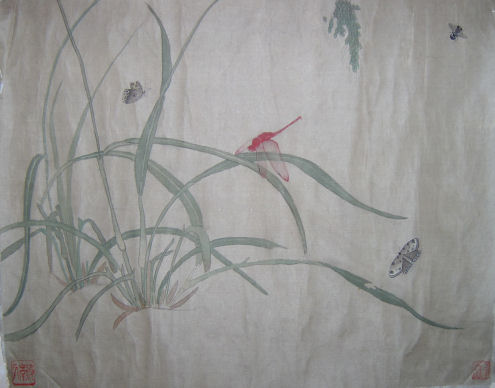
Gongbi painting by Anders Ofverstrom (copy)
Generaly
you can say that many artists after a completed examination was given
an official position by the court, some were chosen to academies,
institutions, societys, some was given direct comissions. At the
institutions they were given some sort of influnce and regular
income, in return they had to work on commsions or teaching. The
shape of these institutions vary with emperors and dynastys. These
were proffesional artists and useally painted in the ”Gongbi”
style they considered the ”wenren huajia”
litterati artists to be amateures while the litterati artist thought
of themself to be above the mundane and did not paint for money or
commision but only for oneselfs pleasure and cultivation.
It is
in the same way the art institutions works in modern China with
exeption that artists from the Xieyi school are represented in
majority.
The Xieyi school puts its emphesis on the
spiritual and philosofical aspect of painting.
Xieyi means
writing down Intention/Idea or thought, it is the same yi
as in Yiquan.
As
I continue I hope that you can draw more paralells betwen Xieyi
painting and Neijia quan (Yiquan/Taikiken/Yoshinken/Shinbuken.)
and pherhaps to life it self and how it should be lived.
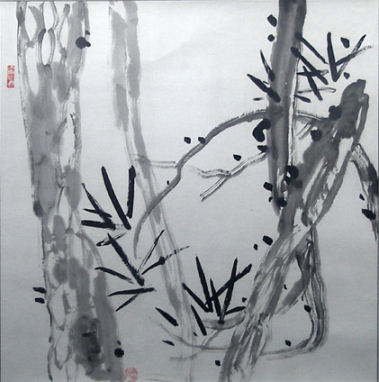
Pine in Xieyi style by Anders Ofverstrom
So
why is it called Xieyi, "write idea" and not
paint idea? Because it describes how the painting tecnique should be
done! One of the most famous artists within the Xieyi tradition, Wu
Changsuo (1844-1927) said "-You shall write the painting and
paint the writing". First you must have inspiration, then you
must have a clear image of the painting in your mind, an
idea and when you start to paint it
has to have
the flow of running water, spontainious but at the same time firm,
just like when you write, no hesitation, you dont hesitate when you
write because you have written the same letter hundred thousand times
so you have learned it by heart ("xin" "shin")
and it comes natural without thought. it´s just like in martial
arts where you must have repeated the technique thousands of times
before you can use it natural and with flow. With other words you
must posses the gongfu wich the task demands. To add to this in
Chinese painting you can not change something afterwards so when you
put the brush on the paper it´s defenitive, just as in Tanshu
when you made your first mistake you are beaten and you have to
stop.
1500 years ago Xie He an artist and art critic wrote six
criteria for good painting:
1. Qiyun Shendong -
pulsate with Qi and
living movement. ( It is because the brush strokes and the
compostion have Qi that makes the painting flow (breath) with Qi and
makes it come
alive, without Qi it becomes static and dead) Xie He thought this the
most important quality so he put it as number one and it´s this
quality that gave the Chinese painting its distinctive character.
This rule are considered the most important even today. (Qi is the
fundamental essense in our training)
2. Gufa
Yongbi - to use skelleton technique in the brush
strokes. with this he means that the brush strokes should not only
have the design of a skelleton bone but also that the strokes must
have the same use as a skelleton, the must have the power and
stability to uphold the the whole painting. (We must have the right
posture in every movement)
3. Yinwu Xiangxin – what
you depict have to reflect the objects
charactersitics.
4. Shuile Fucai -
use fitting colours
5. Jingyin Weizhi - make
good compositions
6. Chanyi Moxie - You
shall learn by immitating but you have to change and create.

Lotus by Anders Ofverstrom
The common idea among art critics after Xie He was that you could
achieve all this through laborious pracise exept the first rule which
they thought that only a few was gifted with.
Xie He's six rules for painting have been altered and expanded up to
this date but the principle remains the same. If we look at the order
of these six rules we can see that composition and colouring is at the
bottom of the scale this implicates that realism and reproduce nature
was not purpose but rather paint the spirit of the object.
As a result of this other art/philosofic terminology have sprung out,
such as:
(I belive that through looking at the
terminology we can easer understand the qualities of Xieyi painting)
Yixiao kanda - to see the
big in the small / to open your senses.
Kongbai - empty space /
to get the viewers imagination started and to harmonise the composition.
Busi zhisi - the likeness
off unlikeness / brings out the typical charecteristics in the object
you paint so you recognize it not from its shape but from its
charectaristics , in this way easyer understand it's soul. ( You can
not get to know a person by looking at his/hers appearance but through
his/hers character you can.)
Kuazhang - exaggerate /
to emphesize on whats important and bring out the charectaristics of
the object.
Duibi - contradictions /
to harmonise and dramatize. Interactionwith Qi between empty and filled
spaces, yin/yang.
Jianhua - simplify / to
make your idea visible.
Qi - Qi / to make the
painting alive with the energy of natures own life puls.
Zhuo - clumsy in a
positve aspect / to reinforce the characteristics of the artist. To
show true intention.
Xinyin - heart print /
the painting should be as a print of the artists heart and soul.
Without these qualitys a painting is mere ink scribble.
I think for those whom have practised Neijia "internal martial arts"
it's easyer to see these qualitys in a brush stroke.
To try to explain in detail how you can see these qualitys is very
difficult , It's like trying to explain what Qi is, the best way is to
practise. Lin Fengmian (1900-1991)
who started to hold the first classes at Zhejiang academy of fine arts
was taken aback when it came to what method he was to use when teaching
Xieyi painting and he
said "- now I have to teach something that cannot be teached". Xieyi
must grow from inside and are shaped from the artists ego and
character.
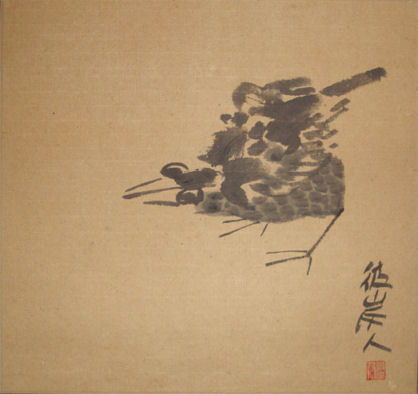
Bird by Anders Ofverstrom
As a speaker of the Chinese language I have come across events and
persons in China which fits in to the frame of "art and Qi", one of the
more funnier ones are the following:
At the art academy in Hangzhou we attended a course in calligraphy, the
teacher was also a Qigong master who
was using his Qi in his calligraphy.
He had piercing eyes an as soon your eyes met his you had to lower your
head. He always started each term with asking; -what is Qi?.
This time he asked a student for a coin, then he put it between his
longfinger and ringfinger and broke it in half with his thumb, at
another occasion he had broken a table in half with a swift blow. After
his demonstration he explained to the students that he did not accept
late commers or talking during his lessons, the students obeyed this
without objection. Later in the term there was a knock on the door
during his class and the teacher looked curious at he door and wondered
who had the guts to disturb his lesson, a mans voice was calling one of
the female students from the other side of the door. At this instant
everybody knew that it was one of the teachers whom had a relationship
with one of the female students. The Qigong master
who was a man of moral and virtue had of course knowledge about this
highly improper relationship, now gathered his Qi and
waited until the door slowly opened, then released his Qi and hit the
table which flow across the class room and hit the door which closed
with a BANG. This time the table broke as well, to the growing anger of
the caretaker.
One Daoist expression used in both Xieyi
painting and Yiquan is Wuwei which
is translated non action.
In Xieyi painting this means to create without thought, to
follow the nature of your personal qualitys or call it the inborn
reaction of the circumstances. We can find this quality in a good Tanshu
as well.
Wuwei is besides of Yijing "the highest idea
expression" and Qiyun "pulstating Qi" the most
important quality in Xieyi painting. Not to forget is that to
use Wuwei systematicly demands a lifetime of training along
with creativity, orginality, an open mind and a genious. Some artists
used wine in order to easyer attain this state of mind. Su Dongpo
(1037-1101) a poet, artist, art critic, connoisseur and official wrote
about the subject in the following poem:
When my lips touch the moister of the wine
my guts grows and split
and out of my liver and lungs
grows bamboo and rocks
unresistebly
they find their expression on your white wall
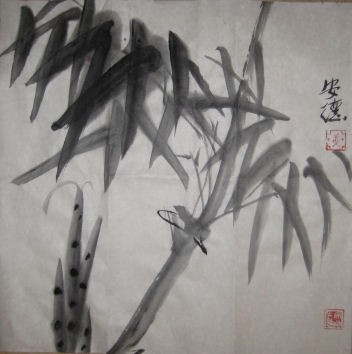
Bamboo by Anders Ofverstrom
Zhang Xü (8th century) entitled inventor of the
wild cursive calligraphy, acording to contemporarys he behaved in a
crazy manner shouting and screaming while writing, often in a drunken
state, it is said that he even used his head and hair as a brush.
Du Fu (712 - 730) poet, describes Zhang Xü
in his poem
...and three cups of wine makes Zhang Xü a master
he tear his hat off
without cermonies he stands in front of the princes
bareheaded he handles the inspired brush
his callicraphy flows fourth like raging clouds...
Xieyi painters saw themselfs as the
opposit of the Gongbi painters. Gongbi
painters was according to the Xeiyi painters
crafstmen and not artists they put to much effort on technique and
surface while the Xieyi painters emphesized cultural
spirit and to do this you you had to be a cultivated person, anyone can
learn technique and craftmanship but to beeing a cultivated person also
demanded that you lived by the virtues ”Ren yi dao de” goodness,
righteousness, Dao (the way) and good morality. I you
dont live by these virtues it will show in your brush strokes and other
connoisseurs and artists will reject your art no matter how skillful
you are.
Shi Tao (1642-1707) spoke in his art theory of
the all-embracing brush stroke where the brush strokes seemed to
randomly spring up from nowhere and where the artist had to penetrate
into the smallest aspects of matters to be able to give spiritual life
to mountains and floods, open and closed landscapes, all living and
growing and to humans manifistations. This all-embracing brush stroke
is pherhaps best described by Cai Yong who wrote around 150 A.D about the art of
writing.
When you write you must first make
yourself free from your thoughts and indulge yourself in your feelings.
Let your nature follow its incliantion. If you feel the slightest
low-spirited, bound or forced you will not succed even if your pencils
hair is made out of the finest Zhongshan hare. your writings forms
shall give vissions of lying and standing, flying and going, comming
and going, lying down and standing upp, sharp swords and keen spears,
of strong bows and sharp edged arrows, mist and skyes and of the sun
and the moon - all this shall speak in your writing, only then can it
be called calligraphy.
Read this once more and think of Tanshu
Budo has a lot in common with the Chinese Xieyi
tradition, for some of you this is well known to some of you this might
feel familiar but at the same time new. It is not by a mere accident
that the famous Miamoto Musashi (1584 - 1645) also
was a master of Xieyi painting or Chanpainting
as it was called then, Zenpainting in Japan.
The key to succes lies within the name of the branch of martial art we
practise, Yoshin(ken) in Japanese or Yangxin(quan)
in Chinese is a concept that propably originates from Xünzi
(a confucian philosopher ~312-330).
Yangxin directly translated means cultivate heart, where the
heart means both body and soul. Xünzi put it
this way in his book Xünzi, chapter cultivate
the body:
" All methods which nourish Qi and cultivates the heart must go through
rules and regulations, you can only attain this by yourself, not get it
from a master or from immortals. This is the true way to attain
cultivation of heart and Qi".
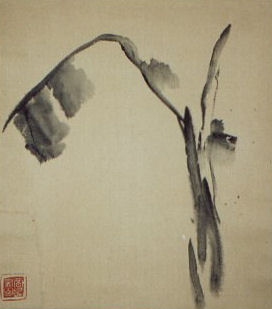
Banana tree by Anders Ofverstrom
Yangxin became more of a
Daoist expression. In "The immortals of the west mountains" meeting
records they write the following regarding Yangxin:
"Zhenren shangxian
Jiaoren Xiudao
Jixin xinye
Jiaoren xiuxin
Jixin daoye"
"True humans thet have become immortals, teach people to cultivate Dao
It is the same as cultivate the heart
They teach people to cultivate the heart, which is the same as
cultivate Dao"
The Daoists belives that it is in the heart where all feelings and
desire is born, the right way to control negative feelings and desire
is by cultivating the heart which is done through both spiritual and
physical exercises.
We can also find the expression Yangxin in Chinese
medicin where it is a way of nourish the heart when it suffer from lack
of Yang Qi (like in Yin/Yang),
which results in nervousity, insomnia, sexual disfunctions etc.
Another way to cultivate yourself which goes back more than a thousand
year is "Qin Qi Shu Hua" - to cultivate oneself
through playing "Qin" a chinese Zither, playing chess,
write calligraphy and paint. These are counted as cultural arts "Wen".
There is an idiom called "Wenwu Shuangquan" which
means with both cultural and martial arts you become complete.
Yoshimichi Sato could not have chosen a
better name than Yoshinken (Yanxinquan)
to Marshall Mcdonagh when he created his branch of Taikiken
which has its roots in Yiquan.
I was not only happy to discover how much Yoshinken
had in common with Xieyi painting
but also to find a teacher who understood and could mediate these, not
only a teacher and master of martial arts but also to widen the
awareness on both the spiritual and everyday life. Through compassion.
honesty, true intention, inspiration and deepening in one thing
understand thousands of other, "Yixiao kanda" see the
big through the small / to open your mind.
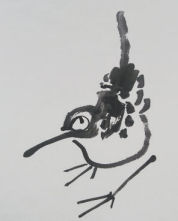 Anders Öfvesröm 2007-09
Anders Öfvesröm 2007-09
|
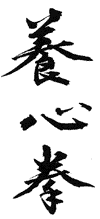 Yoshinken
Yoshinken |

 Anders Öfvesröm 2007-09
Anders Öfvesröm 2007-09





